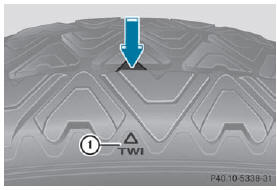Tire tread
![]() WARNING
WARNING
Although the applicable federal motor vehicle safety laws consider a tire to be worn when the tread wear indicators (TWI) become visible at approximately 1/16 in (1.6 mm), we recommend that you do not allow your tires to wear down to that level. As tread depth approaches 1/8 in (3 mm), the adhesion properties on a wet road are sharply reduced.
Depending upon the weather and/or road surface (conditions), the tire traction varies widely.
Do not use tires that are excessively worn as the tire traction on wet road surfaces decreases significantly when the tread depth is less than 1/8 inch (3 mm).
Tread wear indicators (TWI) are required by law. Six indicators are positioned on the tire tread. They become visible as soon as a tread depth of approximately 1/16 inch (1.6 mm) has been reached. If this is the case, the tire is so worn that it must be replaced.
The recommended tread depth for summer tires is at least 1/8 inch (3 mm). The recommended tread depth for winter tires is at least 1/6 inch (4 mm).

Bar marking 1 for tread wear is integrated into the tire tread.
See also:
Activating/deactivating
The evaporator is ventilated when the airconditioning system is operated. The
blower is activated automatically approximately one hour after the vehicle has been
locked. The blower operates on ...
Introduction
SRS consists of:
Х the SRS warning lamp
Х air bags
Х air bag control unit (with crash sensors)
Х Emergency Tensioning Devices
Х belt force limiters
SRS reduces the risk of occupants coming
in ...
Fastening seat belts
WARNING
According to accident statistics, children are
safer when properly restrained on the rear
seats than on the front-passenger seat. Thus,
we strongly recommend that children be
...
